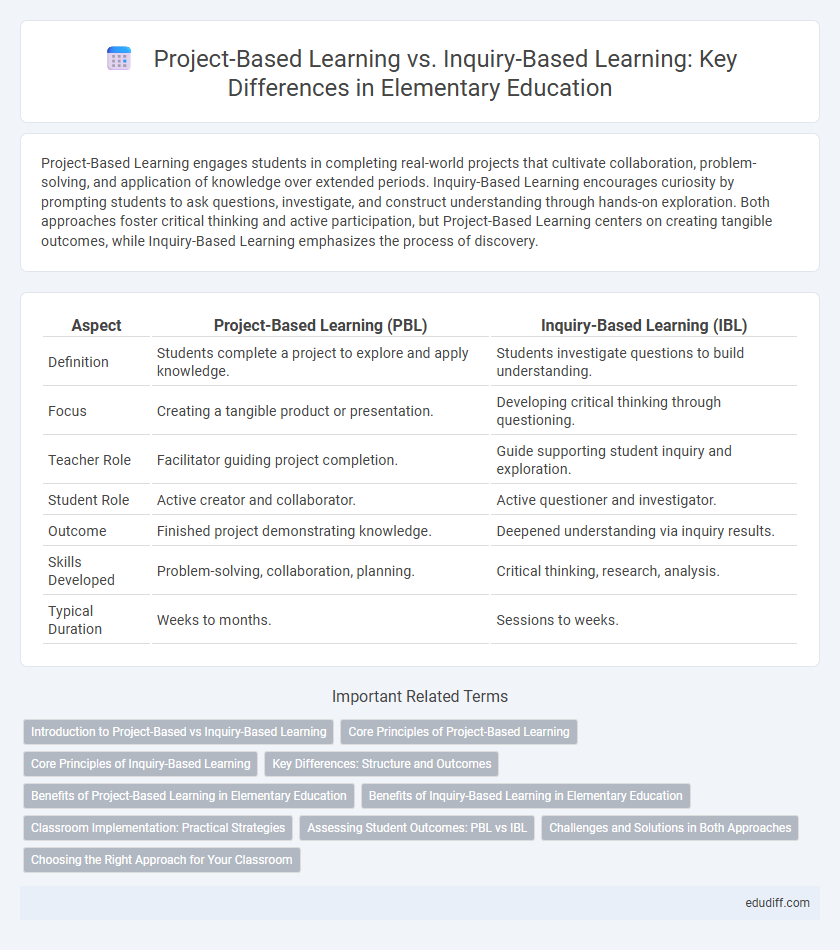Project-Based Learning engages students in completing real-world projects that cultivate collaboration, problem-solving, and application of knowledge over extended periods. Inquiry-Based Learning encourages curiosity by prompting students to ask questions, investigate, and construct understanding through hands-on exploration. Both approaches foster critical thinking and active participation, but Project-Based Learning centers on creating tangible outcomes, while Inquiry-Based Learning emphasizes the process of discovery.
Table of Comparison
| Aspect | Project-Based Learning (PBL) | Inquiry-Based Learning (IBL) |
|---|---|---|
| Definition | Students complete a project to explore and apply knowledge. | Students investigate questions to build understanding. |
| Focus | Creating a tangible product or presentation. | Developing critical thinking through questioning. |
| Teacher Role | Facilitator guiding project completion. | Guide supporting student inquiry and exploration. |
| Student Role | Active creator and collaborator. | Active questioner and investigator. |
| Outcome | Finished project demonstrating knowledge. | Deepened understanding via inquiry results. |
| Skills Developed | Problem-solving, collaboration, planning. | Critical thinking, research, analysis. |
| Typical Duration | Weeks to months. | Sessions to weeks. |
Introduction to Project-Based vs Inquiry-Based Learning
Project-Based Learning (PBL) immerses elementary students in hands-on projects connected to real-world problems, fostering critical thinking and collaboration skills. Inquiry-Based Learning (IBL) centers on student-driven questioning and exploration, promoting curiosity and deeper understanding of concepts. Both methods enhance engagement but differ in structure: PBL emphasizes creating tangible outcomes, while IBL focuses on the investigative process.
Core Principles of Project-Based Learning
Project-Based Learning (PBL) centers on student-driven projects that address real-world problems, fostering collaboration, critical thinking, and hands-on engagement. Its core principles include sustained inquiry, student autonomy, and authentic assessment aligned with clear learning goals. By integrating interdisciplinary content and encouraging reflection, PBL enhances deeper understanding and skill development in elementary students.
Core Principles of Inquiry-Based Learning
Inquiry-Based Learning centers on students' curiosity, encouraging exploration and questioning to develop critical thinking skills. It emphasizes active investigation, where learners construct knowledge through hands-on experiences and reflective analysis. This approach fosters independence and deeper understanding by allowing students to guide their own learning process.
Key Differences: Structure and Outcomes
Project-Based Learning (PBL) emphasizes structured, long-term projects that culminate in tangible products, fostering collaboration and real-world problem-solving skills for elementary students. Inquiry-Based Learning (IBL) centers on students' questions and exploration, promoting critical thinking and deep understanding through investigation with less predefined structure. Outcomes in PBL typically result in measurable project deliverables, while IBL prioritizes cognitive development and mastery of inquiry skills.
Benefits of Project-Based Learning in Elementary Education
Project-Based Learning in elementary education fosters critical thinking, collaboration, and real-world problem-solving skills by engaging students in hands-on, meaningful projects. This approach enhances retention and understanding by allowing students to connect academic concepts to practical applications. Research shows that students involved in Project-Based Learning demonstrate higher motivation and improved communication skills compared to traditional teaching methods.
Benefits of Inquiry-Based Learning in Elementary Education
Inquiry-based learning in elementary education fosters critical thinking and nurtures curiosity by encouraging students to explore questions and problems actively. This method promotes deeper understanding and retention of knowledge through hands-on investigation and collaboration. It enhances student engagement and empowers learners to develop independent research skills essential for lifelong learning.
Classroom Implementation: Practical Strategies
Project-Based Learning engages elementary students through hands-on projects that integrate multiple subjects, fostering collaboration and real-world problem solving. Inquiry-Based Learning encourages curiosity by having students pose questions, conduct investigations, and develop critical thinking skills through guided exploration. Effective classroom implementation combines clear objectives, structured guidance, and opportunities for reflection to support young learners' active participation and deeper understanding.
Assessing Student Outcomes: PBL vs IBL
Assessing student outcomes in Project-Based Learning (PBL) emphasizes tangible product creation and real-world application, measuring skills like collaboration, problem-solving, and creativity through rubrics and presentations. Inquiry-Based Learning (IBL) assessment focuses on students' critical thinking, inquiry processes, and depth of understanding, often evaluated through reflective journals, research findings, and questioning techniques. Both methods require formative and summative assessments but differ in prioritizing final project outputs versus inquiry skills mastery.
Challenges and Solutions in Both Approaches
Project-Based Learning (PBL) often faces challenges such as managing time effectively and ensuring student engagement throughout long-term tasks, which can be mitigated by breaking projects into smaller milestones and incorporating regular feedback sessions. Inquiry-Based Learning (IBL) struggles with guiding students to develop meaningful questions and maintaining focus during open-ended investigations; teachers can address these issues by providing structured question prompts and scaffolding research skills. Both approaches benefit from integrating collaborative tools and differentiated instruction to support diverse learning needs and enhance overall student outcomes in elementary education.
Choosing the Right Approach for Your Classroom
Project-Based Learning engages elementary students by allowing them to explore real-world problems through extended projects, fostering collaboration and creativity. Inquiry-Based Learning encourages curiosity and critical thinking by having students ask questions and investigate topics independently or in small groups. Selecting the right approach depends on your classroom goals, available resources, and the students' learning styles to maximize engagement and understanding.
Project-Based Learning vs Inquiry-Based Learning Infographic

 edudiff.com
edudiff.com